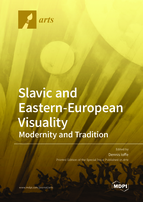Slavic and Eastern-European Visuality: Modernity and Tradition
A special issue of Arts (ISSN 2076-0752).
Deadline for manuscript submissions: closed (15 August 2022) | Viewed by 41907
Special Issue Editor
Interests: area studies; literary studies; media; philosophy; history of religions; art history; theatre and performing arts; translation studies; comparative cultural history; language and text analysis
Special Issues, Collections and Topics in MDPI journals
Special Issue Information
Dear Colleagues,
The long 20th century is arguably the most turbulent and complex of all grand-scale periods in the history of European visual art. Eastern Europe is no exception in this context, and if anything, a prime example of the veritable explosion culture underwent during this period. Many Eastern European authors and artists made more than sizeable contributions to this explosion in many directions and experimental forms. Modernism viewed as a totality of aesthetic principles and theories began to take shape already during the second half of the nineteenth century and achieved a measure of aesthetic coherence before the First World War. Despite the absence of an all-encompassing theoretical manifesto, this “modernist urge” displayed several consistent aesthetic principles and methods of creation that resulted in a fundamental revision of the universal values that had been previously culturally dominant. Modernism permanently struggled with tradition. How do we define “tradition”? How do we define “experimental visuality”? What are some of the intriguing case studies Eastern Europe can offer in this respect?
This special volume is set to explore how tradition coexisted with various modernist visualities, how innovation combatted archaicism, how powerful art institutions along with political regimes shaped this entire scene of visual and literary action over the last two and half centuries, up until the present day. We adopt Jürgen Habermas’ view of modernity and modernism as a fundamentally unfinished project. Initiated by the combatant philosophy of Enlightenment (starting from 18th century), “the project of modernity” offers a form of permanent progress and constant change, the everlasting state of evolvement that cherishes art’s autonomous status which answers to its intrinsic immanent logic of “total representation”.
We invite potential contributors to submit original articles, whether theoretical or historical, interdisciplinary, or field focused, but always centered on the dominant idea of Eastern European creative visuality, but especially ekphrasis. We do not limit our contributions with regard to any strict chronology. We are particularly interested in all subjects that deal with the primary sources and origins of Russian and East European modernism, avant-garde and post-avant-garde(s) discussed as a contested encounter with “traditional past” or with “abstract time”.
Other topics of interest include aspects of the history of Russian and Eastern European art in general, various methodological challenges in the field, and evolving aesthetics, considered through the varied lenses of theory, history, and resulting creative practices.
Prof. Dr. Dennis Ioffe
Guest Editor
Manuscript Submission Information
Manuscripts should be submitted online at www.mdpi.com by registering and logging in to this website. Once you are registered, click here to go to the submission form. Manuscripts can be submitted until the deadline. All submissions that pass pre-check are peer-reviewed. Accepted papers will be published continuously in the journal (as soon as accepted) and will be listed together on the special issue website. Research articles, review articles as well as short communications are invited. For planned papers, a title and short abstract (about 100 words) can be sent to the Editorial Office for announcement on this website.
Submitted manuscripts should not have been published previously, nor be under consideration for publication elsewhere (except conference proceedings papers). All manuscripts are thoroughly refereed through a double-blind peer-review process. A guide for authors and other relevant information for submission of manuscripts is available on the Instructions for Authors page. Arts is an international peer-reviewed open access semimonthly journal published by MDPI.
Please visit the Instructions for Authors page before submitting a manuscript. The Article Processing Charge (APC) for publication in this open access journal is 1400 CHF (Swiss Francs). Submitted papers should be well formatted and use good English. Authors may use MDPI's English editing service prior to publication or during author revisions.
Keywords
- modernism
- avant-garde
- Russian art
- Eastern Europe
- visual studies
- art history
- ekphrasis
- cultural history





